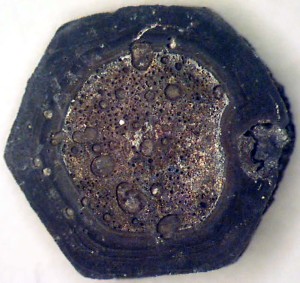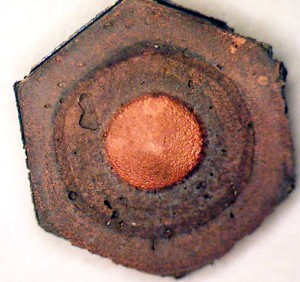Silicon Rectifier PX6A07
This is a 6 amp plastic encapsulated silicon rectifier (PX6A07). Several of these high current diodes failed in the application.
The arrow points to the spot of one of the failures on one device after the epoxy and copper lead frame was removed.
The picture on the right is the anode. In the middle is the copper contact and the ring is actually the contact via solder to the P+ region of the die. There is a glass oxide extending from the sides of the die inward to meet the P+ region. Under the glass oxide, there is a P-type guard ring(s), which do not invert when the P+ (anode) is powered. These isolated diffused P rings break down if the voltage is excessive (beyond the specification). The P rings prevent the voltage from extending laterally to the die edge.
The failures all depicts a voltage overload which overwhelmed the guard ring and shorted the anode and cathode junction.
Gideon routinely determines the causes of failures in electrical components. Gideon has over 350 companies that have had failure analysis performed on discrete components, ICs, transformers, capacitors, resistors, relays, etc. Because of the global market, counterfeit parts have been plaguing the industry with inferior ICs that are untraceable. Get control of your product line by using Gideon Analytical Labs’ extensive experience to solve the problem.

EOS in silicon

Metallization contact to silicon